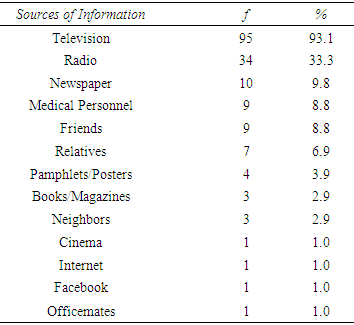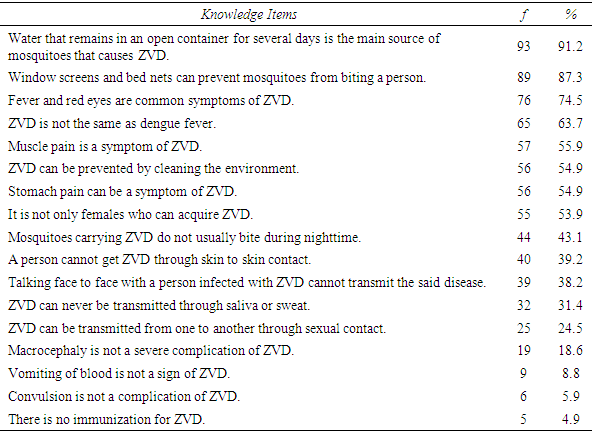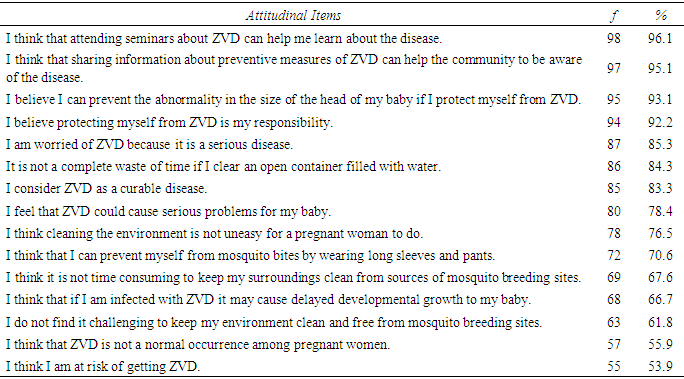-
Paper Information
- Paper Submission
-
Journal Information
- About This Journal
- Editorial Board
- Current Issue
- Archive
- Author Guidelines
- Contact Us
Public Health Research
p-ISSN: 2167-7263 e-ISSN: 2167-7247
2018; 8(5): 115-120
doi:10.5923/j.phr.20180805.03

Knowledge and Attitude toward Zika Virus Disease among Pregnant Women in Iloilo City, Philippines
Blanche Therese P. Ricamonte , Christela Claire G. Jover , Ryan Michael F. Oducado , Emmi Jane M. Ngitngit , Andrea Yvone S. Hiponia, Grant Hill P. Macables
College of Nursing, West Visayas State University, Iloilo City, Philippines
Correspondence to: Ryan Michael F. Oducado , College of Nursing, West Visayas State University, Iloilo City, Philippines.
| Email: |  |
Copyright © 2018 The Author(s). Published by Scientific & Academic Publishing.
This work is licensed under the Creative Commons Attribution International License (CC BY).
http://creativecommons.org/licenses/by/4.0/

The recent outbreak of Zika Virus Disease (ZVD) has caused global and local public health concerns especially among pregnant women and women of reproductive age. A descriptive-correlational survey was conducted to determine the knowledge and attitude toward ZVD among pregnant women in Iloilo City. Using a validated self-completion questionnaire, a total of 102 women seeking prenatal consultation in District Health Centers in Iloilo City were conveniently chosen as study participants. Descriptive and non-parametric inferential statistical tools were employed to analyze the data. Results indicated that the most common sources of information about ZVD were the television and radio. Majority of pregnant women had low level of knowledge but had positive attitude toward ZVD. Only a few knew that the disease can spread through sexual contact. While many pregnant women felt that ZVD is a serious disease that can cause serious problems to their babies, only a little more than half believed that they are susceptible of acquiring the disease. A significant relationship was found between knowledge about ZVD and attitude toward the disease. The findings suggest that public health intervention programs must address knowledge gaps and focus on correcting misconceptions to raise awareness and promote favorable attitude toward ZVD.
Keywords: Zika Virus Disease, ZVD, Pregnant women, Public health
Cite this paper: Blanche Therese P. Ricamonte , Christela Claire G. Jover , Ryan Michael F. Oducado , Emmi Jane M. Ngitngit , Andrea Yvone S. Hiponia, Grant Hill P. Macables , Knowledge and Attitude toward Zika Virus Disease among Pregnant Women in Iloilo City, Philippines, Public Health Research, Vol. 8 No. 5, 2018, pp. 115-120. doi: 10.5923/j.phr.20180805.03.
Article Outline
1. Introduction
- Zika Virus Disease (ZVD) is caused by a virus transmitted by Aedes mosquitoes [1]. The Zika virus is known to circulate in Africa, America, Asia, and the Pacific region and had only been known to cause sporadic infections in humans until 2007, when an outbreak in Micronesia infected 31 people [1]. In the 2016 World Health Organization (WHO) Zika situation report, 70 countries and territories have reported evidence of mosquito-borne Zika virus transmission since 2007 with 53 countries having a first reported outbreak from 2015 onward [2].According to the Philippine Department of Health (DOH), as of February 2017, a total of 57 Zika cases were reported in the Philippines [3]. There were 38 (67%) females and 19 (33%) males with age ranging from 7 years to 59 years were infected with Zika virus although no mortality case was reported [3]. Twelve (12) cases were from the Western Visayas, 11 cases were reported in Iloilo City and one (1) case was reported in Oton, Iloilo [4].With the increasing reported cases of ZVD, public health practitioners must use research-based evidence judiciously to plan community interventions to protect the public from the spread of the disease. In order for these interventions to be effective, program strategies must be carefully planned taking into consideration the needs, expectations and interests of various stakeholders [5]. Given the current outbreak of ZVD, research resources are now being allocated to close many of the knowledge gaps identified [6]. Moreover, there is also no currently available treatment for ZVD [7]. Hence, public health response is geared towards prevention of infection mainly among pregnant women where one of its severe complications is microcephaly in babies born to infected mothers [7].The spread of ZVD has caught the interest of scholars, however, historically there has been little research on ZVD [6]. A recent scoping review of ZVD literature from 2011-2016 identified several knowledge gaps regarding Zika virus’ epidemiology, transmission and complications [6]. Further, majority of studies reviewed by the researchers were conducted abroad in countries like Malaysia, Indonesia, India, Saudi Arabia, Greece and in the United States. Since ZVD outbreak in the country is relatively new, there is a dearth of published studies yet about ZVD. Therefore, the researchers find it is necessary to provide local evidence by assessing the prevailing knowledge and attitude of pregnant women regarding ZVD in Iloilo City.This study determined the knowledge and attitude toward ZVD among pregnant women seeking prenatal consultation in District Health Centers in Iloilo City, Philippines. Specifically, this study aimed to answer the following questions: 1) What are the sources of information of pregnant women about ZVD? 2) What is their level of knowledge about ZVD? 3) What is their attitude toward ZVD? and 4) Is there a significant relationship between the level of knowledge about ZVD and attitude toward ZVD among pregnant women in Iloilo City?
2. Methodology and Methods
2.1. Research Design
- A descriptive-correlational research employing one–shot survey design was utilized in this study.
2.2. Participants
- Using convenience sampling, the participants were the 102 pregnant women who sought scheduled pre-natal check-ups in District Health Centers in Iloilo City. For participants’ characteristics, majority of the pregnant women were 18-25 years old (58.8%), a little over half were either single or not married (54.9%) and attained high-school level of education (52%), with a median monthly family income of 5,800 pesos.
2.3. Data Collection Tool
- The data for this study were gathered with the use of a four-part, self-completion questionnaire. Part One, Personal Data, gathered information about participants’ age, civil status, educational attainment, and monthly family income. Part Two, Sources of Information about ZVD, was a checklist about where pregnant women got information about ZVD. Part Three, Knowledge toward ZVD, was composed of seventeen (17) questions covering cause and transmission, signs and symptoms, complications, and questions relating to prevention and control of ZVD. The participants were asked to choose from three (3) responses: “True”, “False” and “Don’t Know”. Part Four, Attitude toward ZVD, was composed of fifteen (15) items. The participants were asked to respond to two (2) choices: “Agree” or “Disagree”. Forced choice was preferred by the researchers to simplify the instrument since the study was conducted among the general pregnant women population, some might find difficulty in understanding questionnaires that are too lengthy or with too many instructions and choices. The development of questionnaire items was based on existing literature and preliminary interviews that was conducted among ten (10) pregnant women to identify existing knowledge, common understanding, false beliefs and misconceptions about ZVD. The result of preliminary interviews was incorporated in the development of the questionnaire. The instrument was submitted for content and face validation to a panel of four (4) jurors composed of a representative from the DOH Region 6 in charge of ZVD prevention program, a university professor who had conducted a study about ZVD, and two (2) Medical Health Officers. The comments and suggestions of the validators were incorporated in the final English version, which was translated in the local dialect (Hiligaynon) for better comprehension of the questions by the study participants. The translated instrument was translated back to English to ensure correctness in the translation process. The Hiligaynon instrument version underwent pilot testing that was carried out to ten (10) pregnant women who were seeking pre-natal consultation in a nearby Rural Health Unit. All unnecessary, difficult or ambiguous items were discarded and the instrument was revised as deemed necessary.
2.4. Data Gathering Procedure
- Permission to conduct this study was secured from the City Health Officer of Iloilo City and to each Medical Health Officer of the respective Health Centers. The researchers distributed the questionnaire and gathered the data during the scheduled pre-natal check-up of women in the Health Center either while the participants were waiting for their turn or after their consultation. Informed consent form was given in which the participants signed if they wish to partake willingly in the study. The participants were informed that they have the right to refuse and were guaranteed that the gathered data will be used for research purposes only. The researchers distributed the questionnaires to the participants for them to accomplish and the participants were given ample minutes to answer the questionnaire. For those who do not know how to read but were willing to participate in the study, the researchers read the questionnaire for them to respond. Upon retrieval of the research instruments, the researchers reviewed the questionnaire for completeness of data entry.
2.5. Statistical Tools
- The data obtained was subjected to appropriate descriptive and inferential non parametric statistical tools using the Statistical Package for the Social Science (SPSS) Software version 20. Mean, frequency count, percentage, and Spearman Correlation Coefficient were used to analyze and interpret the data gathered.
3. Results
- Table 1 shows that almost all (93.1%) of pregnant women knew about ZVD through television and one-third (33.3%) heard it on the radio. Other sources of information about ZVD were from the newspaper (9.8%), medical personnel (8.8%), friends (8.8%), relatives (6.9%), pamphlets/posters (3.9%), books/magazines (2.9%) and neighbors (2.9%). Only a little of the pregnant women knew about the disease in cinema (1.0%), internet (1.0%) and Facebook (1.0%), and officemates (1.0%).
|
|
|
|
|
|
4. Discussion
- Studies on ZVD in the Philippines is scarce, hence this study investigated on the knowledge and attitude among pregnant women where a higher proportion of birth defects were reported of babies whose mothers were infected with Zika infection in the first trimester of pregnancy [8]. Having baseline data of the knowledge and attitude of pregnant women is an important tool in designing more effective interventions and programs to address local ZVD concern.This study showed that pregnant women in Iloilo City Philippines seeking prenatal consultation in District Health Centers had low level of knowledge about ZVD. Similarly, low level of knowledge was also found among dental practitioners in India, medical doctors in Indonesia, medical students in Saudi Arabia and even among pregnant women in Greece [9-12]. Contrastingly, good knowledge toward ZVD was reported of several studies conducted in Malaysia [13-15]. ZVD outbreaks have only been reported more recently in many countries [2] and ZVD is relatively new in the Philippines therefore public educational campaigns about ZVD may not have been intensified. On the other hand, Zika virus was isolated from a mosquito in Malaysia decades ago in the 1960s [16]. Health sectors in Malaysia may have already initiated public health campaigns raising awareness on ZVD. More importantly, results of the present study suggest that pregnant women are aware of the common breeding site of mosquitoes transmitting ZVD, some of its symptoms and what can be done to prevent the disease. However, pregnant women have inadequate information regarding ZVD transmission especially sexual transmission of the disease. More than half of pregnant women in this study thought that ZVD can be transmitted through saliva, talking face to face and by skin to skin contact. Moreover, other signs and symptoms of ZVD are also less well known to the study participants and that there are also misconceptions about ZVD’s complications. It is significant to note that among the participants of this study, only a few correctly identified that macrocephaly is not a complication of ZVD. During the preliminary interviews conducted by the researchers for the development of the study instrument, a participant mentioned that enlargement of the infants head is a severe complication of ZVD. This may suggest that pregnant women in this study may have a misconception that macrocephaly and not microcephaly is a complication of ZVD. The result of this current study is congruent with the findings of other studies regarding ZVD where women of reproductive age in the United States, medical students in Saudi Arabia, pregnant women in Greece, and sample in Malaysia were aware of ZVD transmission through mosquito bites, but many were unaware that ZVD can be sexually transmitted [17, 18, 11-13]. Television and radio were the major sources of information of ZVD among pregnant women in this study whereas online media was not a well-known source of information. Given that Filipinos have habits of watching television daily, they may possibly be updated to current contagious and relatively new diseases from watching news programs. It must however be taken into consideration that majority of the sample in this study belonged to the low income bracket; therefore internet access maybe low. Further, the result of this study also suggests that pregnant women less likely approach medical personnel or that the healthcare team members may have minimal contribution in raising awareness and educating the public about ZVD. A study in India likewise found that most dental practitioners got their knowledge about ZVD through television [9]. In contrast, online media, internet or Facebook were the main sources of information among doctors in Indonesia, medical students in Saudi Arabia and public information in Malaysia [10, 11, 13, 14]. This study also illustrated that pregnant women had positive attitude toward ZVD. Positive attitude toward ZVD was also reported in studies conducted in Malaysia [13, 14]. Furthermore, medical students in Saudi Arabia also manifested good attitude toward learning about ZVD [11] while poor attitude toward ZVD was conveyed among medical doctors in Indonesia [10]. While overall attitude toward ZVD was positive, primarily on beliefs in taking preventive actions in protecting themselves against ZVD and the effect of ZVD to their babies, only a little more than half of pregnant women in this study were concerned about ZVD and the risk of acquiring it. Samples of studies in Saudi Arabia and Malaysia also did not consider higher risk of getting ZVD [14, 11]. Additionally, only few women of childbearing age in Kentucky, United States were concerned about the effect of ZVD to their babies and a lesser number reported wearing protective clothing as a preventive measure against ZVD [18]. It is also noteworthy that in this study, only about two-thirds of pregnant women were knowledgeable that ZVD and dengue are not the same. The positive attitude toward ZVD of pregnant women may be attributed the fact that pregnant women may have viewed, approached or perceived ZVD as similar to dengue which is an endemic disease in the community over the past years. Pregnant women may have gained more experiences and have been practicing measures to protect themselves against mosquito-borne diseases like dengue.Furthermore, this survey provides information about the association between knowledge and attitude toward ZVD. Most studies that looked into the knowledge and attitude toward ZVD failed to determine the relationship between the two variables. It is demonstrated in this study that pregnant women’s knowledge influence their attitude toward ZVD. When knowledge about ZVD increases, attitude toward the disease also increases. This corroborates with the result of a recent study that revealed statistical significant differences between knowledge levels about ZVD on the attitudinal or health belief constructs of perceived benefits and severity [19].This study has several limitations which include convenience sampling and self-report bias; hence result cannot be generalized among all pregnant women in Iloilo City. Nevertheless, this study provides local baseline data of the existing knowledge and attitude of pregnant women in Iloilo City that can be used in designing public health educational campaigns and programs geared toward ZVD prevention and control.
5. Conclusions
- Pregnant women seeking pre-natal consultation in the District Health Centers in Iloilo City are mainly informed about ZVD through media with minimal contribution among medical or health personnel. While pregnant women have favorable attitude toward ZVD, there are knowledge gaps particularly on the cause and transmission of the disease. Future public health intervention programs should not only focus on diseases with reported mortality cases or reports of severe outbreaks but also in the prevention of sporadic diseases like ZVD. And since ZVD and dengue share the same mosquito vector, the risk to the mother and the baby is ever present and outbreaks can resurge. Continued efforts by the health sectors both in the national and local level are necessary to close knowledge gaps, raise awareness and promote favorable attitudes toward ZVD. Further, surveys in various locations in the country involving larger samples about ZVD knowledge and attitude including practices must be conducted to address the limitations of the present study.
 Abstract
Abstract Reference
Reference Full-Text PDF
Full-Text PDF Full-text HTML
Full-text HTML




